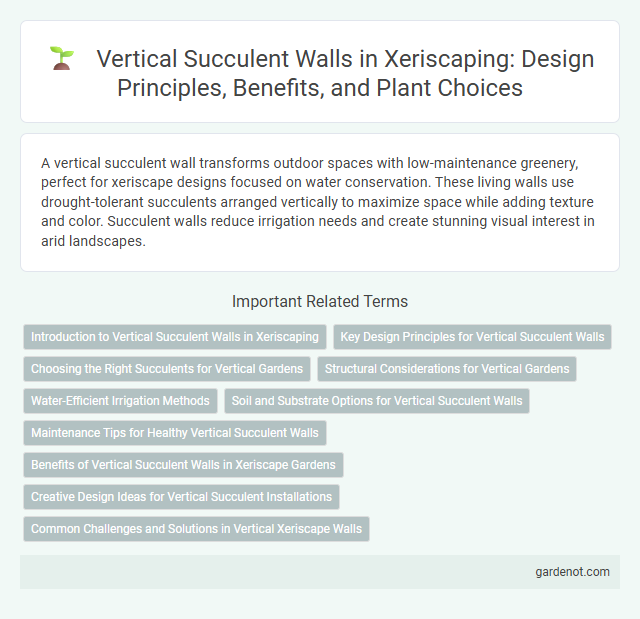A vertical succulent wall transforms outdoor spaces with low-maintenance greenery, perfect for xeriscape designs focused on water conservation. These living walls use drought-tolerant succulents arranged vertically to maximize space while adding texture and color. Succulent walls reduce irrigation needs and create stunning visual interest in arid landscapes.
Introduction to Vertical Succulent Walls in Xeriscaping
Vertical succulent walls in xeriscaping provide an innovative solution for water-efficient landscaping by using drought-tolerant plants arranged vertically to maximize space and reduce water consumption. These walls leverage the natural ability of succulents to store water, creating visually appealing, low-maintenance green installations ideal for arid and semi-arid climates. Incorporating native succulent species enhances biodiversity while promoting sustainable gardening practices in urban environments.
Key Design Principles for Vertical Succulent Walls
Vertical succulent walls require careful consideration of weight distribution, ensuring structural integrity by using lightweight soil mixes and sturdy framing materials like metal or treated wood. Proper irrigation design emphasizes drip systems that provide consistent moisture without oversaturation, promoting healthy succulent growth. Orientation and light exposure are critical; selecting sun-loving succulent varieties and positioning the wall to maximize natural sunlight enhances plant vitality and overall aesthetic appeal.
Choosing the Right Succulents for Vertical Gardens
Selecting the right succulents for vertical succulent walls involves prioritizing drought-tolerant and low-maintenance species like Sedum, Echeveria, and Sempervivum that thrive in limited soil conditions. Plants with shallow root systems and compact growth habits ensure better adherence and longevity in vertical garden structures. Consider sun exposure and watering needs to create a resilient, visually appealing xeriscape vertical garden that conserves water efficiently.
Structural Considerations for Vertical Gardens
Vertical succulent walls require careful structural planning to support the weight of soil, plants, and water retention systems. Utilizing lightweight planting mediums and modular panels reduces load stress on the supporting framework, ensuring long-term stability. Proper anchoring, drainage, and material selection are critical to prevent water damage and structural deterioration in vertical xeriscape installations.
Water-Efficient Irrigation Methods
Vertical succulent walls utilize drip irrigation systems that deliver water directly to the plant roots, minimizing evaporation and runoff. These walls often incorporate moisture sensors to regulate watering schedules based on real-time soil humidity, enhancing water conservation. Efficient irrigation techniques like these reduce water usage by up to 50% compared to traditional methods in xeriscape landscaping.
Soil and Substrate Options for Vertical Succulent Walls
Optimal soil and substrate options for vertical succulent walls include well-draining, lightweight mixtures that prevent water retention and root rot. A blend of cactus potting soil, pumice, perlite, and coarse sand creates an ideal environment that supports healthy root growth and moisture control. Incorporating organic matter like coconut coir or bark chips enhances aeration while maintaining adequate nutrient levels for succulent vitality in xeriscape designs.
Maintenance Tips for Healthy Vertical Succulent Walls
Vertical succulent walls require minimal watering, ideally once every two to three weeks, to prevent root rot and ensure healthy growth. Regular pruning of dead or overgrown leaves promotes airflow and reduces the risk of fungal diseases. Using well-draining soil and ensuring adequate sunlight exposure supports robust succulent development in vertical gardens.
Benefits of Vertical Succulent Walls in Xeriscape Gardens
Vertical succulent walls significantly enhance xeriscape gardens by maximizing limited space while reducing water consumption through drought-tolerant plant selection. These living walls improve air quality and provide natural insulation, contributing to energy efficiency in garden environments. Their low maintenance requirements and vibrant textures also create visually appealing landscapes that thrive in arid climates.
Creative Design Ideas for Vertical Succulent Installations
Vertical succulent walls transform small spaces by incorporating drought-tolerant plants that thrive with minimal water. Innovative design ideas include geometric patterns, mixed textures with varying succulent species, and the integration of LED lighting to highlight natural colors. Modular panels and self-watering systems enhance maintenance efficiency, making these installations both aesthetically pleasing and sustainable.
Common Challenges and Solutions in Vertical Xeriscape Walls
Vertical succulent walls often face challenges such as uneven water distribution and root rot due to improper drainage. Using well-draining soil mixtures and integrating drip irrigation systems ensures consistent moisture levels, preventing overwatering issues. Regular maintenance like trimming and monitoring for pests helps sustain plant health in vertical xeriscape installations.
Vertical succulent wall Infographic

 gardenot.com
gardenot.com